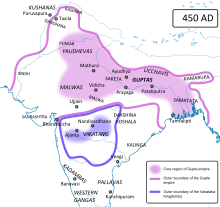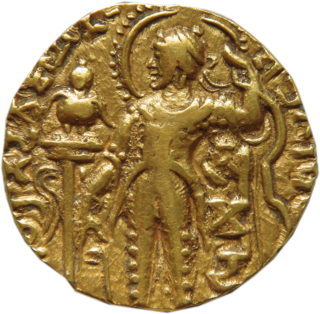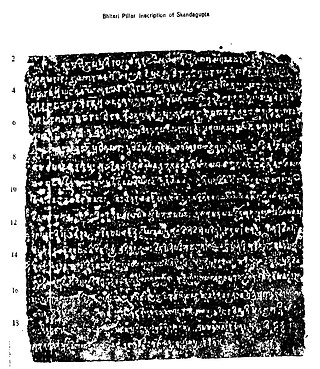

The Pushyamitras were a tribe who lived in Central India during the 5th century CE. Living on the banks of the river Narmada, they are believed to have posed a serious threat to the Gupta Empire during the late period of Kumaragupta I's reign.


The Pushyamitras were a tribe who lived in Central India during the 5th century CE. Living on the banks of the river Narmada, they are believed to have posed a serious threat to the Gupta Empire during the late period of Kumaragupta I's reign.
K. P. Jayaswal believed that the Pushyamitras were in western Malava and were known, in the Gupta period, as Avantyas who were under or in the confederacy of the Abhiras. [1]
The Puranas record thirteen kings of the Pushyamitra dynasty and have been placed in the 3rd century of the Common Era. [2]
The Pushyamitras are only known from the inscription of Skandagupta in which he emphasizes his role in defeating the Pushyamitras, of which the reading is sometimes disputed (it could be "Yudhy-amitrdths-cha" rather than "Pushyamitrams-cha"), as well as a single mention in the Puranas. [3] Therefore their existence is sometimes doubted. The people Skandagupta fought could more probably have been a confederation including the Vakatakas. [3] The dynasty of the Vakatakas ended around that time in a war, when, according to the Dashakumaracharita , attacking the area of Vanavasi to the south, they were in turn attacked from the rear resulting in the death of the last Vakataka king.
Inscriptions covering the events between 455 and 467 CE emphasize the role of Skandagupta, Kumaragupta's successor, in defeating the Pushyamitras. [4]
By whom, when [Skandagupta] prepared himself to restore the fallen fortunes of (his) family, a (whole) night was spent on a couch that was the bare earth; and then, having conquered the Pushyamitras, who had developed great power and wealth, he placed (his) left foot on a footstool which was the king (of that tribe himself).
The Pushyamitras were subjugated by Skandagupta after a long and strenuous fight, [6] as they "had developed great power and many resources in terms of military & wealth". [6] [2] [3] The inscription says that at one point the situation became so serious that Skandagupta had to pass a whole night on the bare ground (the field). [6] The critical situation was eventually tided over by him & emerged victorious. [2] This victory took place towards the close of Kumaragupta's reign. So Kumaragupta was probably too old to lead the army himself. So his son Skandagupta bore the brunt of the struggle, who was chosen by him to deal with the danger of the Pushyamitras. [6] [3] This victory was so memorable & important, we are told in the Bhitari inscription that people sang the songs of his glory in every nook and corner of the empire. [2] [3] Goyal thinks that the Pandumvamshi king Bharatabala was the king leading the Pushyamitra rebellion. [6]
The Gupta Empire was an ancient Indian empire which existed from the early 4th century CE to early 6th century CE. At its zenith, from approximately 319 to 467 CE, it covered much of the Indian subcontinent. This period has been considered as the Golden Age of India by some historians, although this characterisation has been disputed by other historians. The ruling dynasty of the empire was founded by Gupta, and the most notable rulers of the dynasty were Chandragupta I, Samudragupta, Chandragupta II and Skandagupta. The 5th-century CE Sanskrit poet Kalidasa credits the Guptas with having conquered about twenty-one kingdoms, both in and outside India, including the kingdoms of Parasikas, the Hunas, the Kambojas, tribes located in the west and east Oxus valleys, the Kinnaras, Kiratas, and others.

Chandragupta II, also known by his title Vikramaditya, as well as Chandragupta Vikramaditya, was the third ruler of the Gupta Empire in India.

Chandragupta I was a king of the Gupta Empire, who ruled in northern and central India. His title Maharajadhiraja suggests that he was the first emperor of the dynasty. It is not certain how he turned his small ancestral kingdom into an empire, although a widely accepted theory among modern historians is that his marriage to the Licchavi princess Kumaradevi helped him extend his political power. Their son Samudragupta further expanded the Gupta empire.

Samudragupta (Gupta script: Sa-mu-dra-gu-pta, was the second emperor of the Gupta Empire of ancient India, and is regarded among the greatest rulers of India. As a son of the Gupta emperor Chandragupta I and the Licchavi princess Kumaradevi, he greatly expanded his dynasty's political and military power.

Kumaragupta I was an emperor of the Gupta Empire of Ancient India. A son of the Gupta emperor Chandragupta II and Queen Dhruvadevi, he seems to have maintained control of his inherited territory, which extended from Gujarat in the west to Bengal region in the east.
The Shunga dynasty was the seventh ruling dynasty of Magadha and controlled most of the northern Indian subcontinent from around 187 to 73 BCE. The dynasty was established by Pushyamitra, after taking the throne of Magadha from the Mauryas. The Shunga Empire's capital was Pataliputra, but later emperors such as Bhagabhadra also held court at Besnagar in eastern Malwa. This dynasty is also responsible for successfully fighting and resisting the Greeks in Shunga-Greek War.

Skandagupta was a Gupta Emperor of India. His Bhitari pillar inscription suggests that he restored the Gupta power by defeating his enemies, who may have been rebels or foreign invaders. He repulsed an invasion by the Indo-Hephthalites, probably the Kidarites. He seems to have maintained control of his inherited territory, and is generally considered the last of the great Gupta Emperors. The Gupta genealogy after him is unclear, but he was most probably succeeded by Purugupta, who appears to have been his younger half-brother.
The Kidarites, or Kidara Huns, were a dynasty that ruled Bactria and adjoining parts of Central Asia and South Asia in the 4th and 5th centuries. The Kidarites belonged to a complex of peoples known collectively in India as the Huna, and in Europe as the Chionites, and may even be considered as identical to the Chionites. The 5th century Byzantine historian Priscus called them Kidarite Huns, or "Huns who are Kidarites". The Huna/Xionite tribes are often linked, albeit controversially, to the Huns who invaded Eastern Europe during a similar period. They are entirely different from the Hephthalites, who replaced them about a century later.

The Vakataka dynasty was an ancient Indian dynasty that originated from the Deccan in the mid-3rd century CE. Their state is believed to have extended from the southern edges of Malwa and Gujarat in the north to the Tungabhadra River in the south as well as from the Arabian Sea in the west to the edges of Chhattisgarh in the east. They were the most important successors of the Satavahanas in the Deccan and contemporaneous with the Guptas in northern India.

Ghatotkacha was a pre-imperial Gupta king of northern India. He was a son of the dynasty's founder Gupta, and the father of the dynasty's first emperor Chandragupta I.

Purugupta was an emperor of the Gupta dynasty in northern India. Purugupta was a son of the Gupta emperor Kumaragupta I by his queen Anantadevi. He succeeded his half-brother Skandagupta. No inscription of Purugupta has been found so far. He is known from the Bhitari silver-copper seal of his grandson Kumaragupta III and Nalanda clay sealings of his sons Narasimhagupta and Budhagupta and his grandson Kumaragupta III. From the Saranath Buddha image inscription, it is concluded that he was succeeded by Kumaragupta II. According to Hornell and Raychaudhary, Prakashaditya was another title of Purugupta, although this has now been disproven by Pankaj Tandon, who has definitively shown that Prakashaditya was the Hun king Toramana.

The Naga dynasty ruled parts of north-central India during the 3rd and the 4th centuries, after the decline of the Kushan Empire and before the rise of the Gupta Empire. Its capital was located at Padmavati, which is identified with modern Pawaya in Madhya Pradesh. Modern historians identify it with the family that is called Bharashiva in the records of the Vakataka dynasty.

Pravarasena II was a ruler of the Nandivardhana-Pravarapura branch of the Vakataka dynasty. He was the son of Rudrasena II and Prabhavatigupta, the daughter of the Gupta emperor Chandragupta II. He succeeded his brother Damodarasena as Maharaja. Pravarasena's reign seems to have been mostly peaceful and prosperous, and is noted for an efflorescence of religious patronage.

Vindhyashakti was the founder of the Vakataka dynasty. His name might be derived from the goddess Vindhyavasini, or it could be a title or biruda referring to his patrimony in the Vindhya mountains rather than a personal name.

The Kalachuris, also known as Kalachuris of Mahishmati, were an Indian dynasty that ruled in west-central India between 6th and 7th centuries. They are also known as the Early Kalachuris to distinguish them from their later namesakes, especially the Kalachuris of Tripuri. Their territory included parts of present-day Gujarat, Madhya Pradesh, and Maharashtra. Their capital was located at Mahishmati. Epigraphic and numismatic evidence suggests that the earliest of the Ellora and Elephanta cave monuments were built during the Kalachuri rule.

The Gupta era is a historical calendar era that begins from c. 318–319 CE. It was used by the Gupta emperors, as well as their vassals and their successors in present-day northern India and Nepal. It is identical to the Vallabhi era, which was used in the Saurashtra region of western India, although regional differences lead to a slightly different calculation for the conversion of Vallabhi era years to Common Era (CE).

The Bhitari pillar inscription of Skandagupta was discovered in the village of Bhitari near Saidpur in Uttar Pradesh and dates to the reign of Gupta Empire ruler Skandagupta. Further, the inscription is written in Sanskrit and is 15 feet high.
Govindagupta was a Gupta prince of ancient India. He was a son of Chandragupta II and Dhruvadevi, and a brother of Kumaragupta.

Gupta art is the art of the Gupta Empire, which ruled most of northern India, with its peak between about 300 and 480 CE, surviving in much reduced form until c. 550. The Gupta period is generally regarded as a classic peak and golden age of North Indian art for all the major religious groups. Gupta art is characterized by its "Classical decorum", in contrast to the subsequent Indian medieval art, which "subordinated the figure to the larger religious purpose".

Kahaum pillar is an 8 m structure located in Khukhundoo in the state of Uttar Pradesh. The pillar was erected in the 5th century during the reign of Skandagupta. The pillar has carvings of Parshvanatha and other tirthankars with Brahmi script.